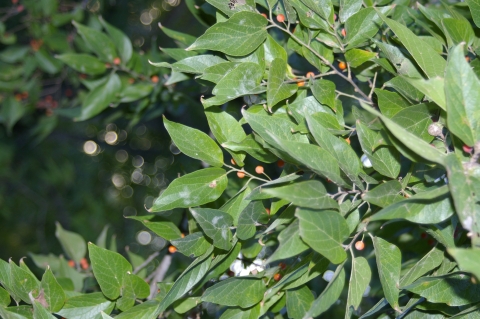In my area, hack berry trees are everywhere. Most folk have bought into the belief that they are a trash tree. Right now, the berrys are red. This means they are ready to eat. Not a big berry, and there is not much flesh on the large seed inside the berry, but it is tasty like a tiny sweet apple. More of a joy than sustanance. It would take a lot to get full on. Still the taste does make me happy.
One of the mallets I use is made from hack berry. If a wood makes a decent mallet, it is far from being trash.
Bob

 A page Dedicated to My Writing
A page Dedicated to My Writing
Hello Bob;
So hackberry would make a suitable wood to work with similar to Osage orange (bodark) and mesquite? We have quite a few down in Sugar Land from the hurricane being sawed up and hauled to the landfill… not even being used for firewood! Of course, there’s lots of oak and hickory down too; so firewood’s gonna be plentiful this year…
Bodark (Bois de Arc?) and mesquite have very different working properties… what are the properties of hackberry.. do you know???
Could I take a large chunk of it and dry it out here and make something out of it??? If so, what???
Skip
Hackberry is a very soft wood while on the tree. It shrinks considerably and becomes a much more dense wood. It must be handled well in curing, because it will split check and fracture with a vengeance. The upside is that it is nearly snow white and can be kept quite white if you treat is carefully. I would not however compare it to Mesquite or Osage. You can bring out the grain on hackberry, and it is fairly durable, so it is well worth keeping and working.
Osage is harder than oak and more flexible than willow while being stable and weather resistant, tough and lovely. Well turned osage can reflect light in a manner that surpasses a lot of gems.
Mesquite will regulary have a grain that stands with the finest and most rare cuts of wood, while being the most dimensionally stable wood in the world.
It is pretty unfair to compare Mesquite and Osage to other woods. In their own ways, they are unequaled.
Another tree commonly considered trash, is the one that GWB clears regulary on his ranch. Yaupon, is pretty much stark white, and really really hard. Intact unsplit and checkered, cured yaupon blocks are also fairly hard to come by, even though it is an extremely common wood in our parts. It is not a large wood, or source for big lumber, but for inlay, it is one of the best woods you can find.
Bob
Interesting, so hackberry is very white in color – I can’t think of any other local woods quite that white. White oak and white ash both have a little color to them. Perhaps it would be good for a project in one of those “washed-on” colors so popular lately, certainly in “washed-white”. Does it take other colors well also?
Other than curing it the normal way – stickered and stacked with sealed ends – what else would need done to it? Kiln-drying?
Thanks for the info on yaupon – whenever I see boxwood used on a tool for hardness – I wonder if yaupon would have similar characteristics? It’s interesting because I just specified that a client use yaupon in a tree planting project this morning.
Skip
I have not worked much with hackberry, I saved a few chunks from a tree I cut. The ones I handled carefully worked out pretty well, but the ones I just set to dry with casual end sealing and just setting in my drying rack were useless with too many splits. Sadly one block spalted wonderfully, but split when I put it on the lathe. I made a froe mallet, http://toolmakingart.com/2008/09/09/froe-mallet-2/
out of hackberry, and then used it to pound, hard directly on the back of a steel blade, in order to split wood. Considering that what I was doing was a sure way to destroy a mallet, The hackberry held up quite well. I used my wax mix on it, which tends to give a nice golden hue to wood, over time. Where the mallet face is mangled, you can see the wood is white.
The hackberry that worked out best for me, I cleaned up all faces, and all surfaces were free of checks and cracks. I sealed the ends by setting them in warm melted wax mix, http://toolmakingart.com/2008/08/06/wax-mix/
I further painted the entire surface with High Linoleic Acid safflower oil. Then the wood was set on a rack in my greenhouse, during the winter where it gets hot, but stays relatively humid. This still did not work out perfectly, but it did better than the ones on my wood rack.
Bob
Do you think kiln-drying it would help, or not? We could always have M & G look out for a log of hackberry and call us if they get one… or take one to them to process…
This sounds like a wet wood like willow oak…..
Skip
The first hackberry wood that I recognized as such was a lovely section of it that was pointed out to me at M&G. Probably a good wood kiln is exactly the right thing for it, since the board they had was flawless.
So not only will it probably kiln fine, but they already know what they are doing at M&G.
Bob